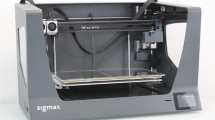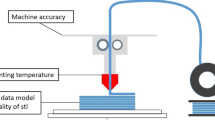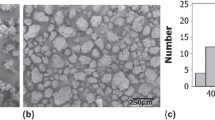Abstract
Multi-material 3D printing and process parameters optimization using multiple extruders are the significant challenges of fused deposition modeling (FDM). This paper focuses on the filament extrusion method and presents a comparison of two modes: multi-material single mixing nozzle and multi-material multiple nozzles, thereby linking technology with the mechanical properties. Tensile testing specimens were printed in two different scenarios to validate the comparison: (1) multi-material multi-layered section printed using a multi in-out single mixing nozzle and (2) multi-material multi-layered section printed using a multiple extrusion nozzle within the same carriage. Both modes followed a rectilinear infill pattern and different material combinations. The material combinations implemented included ABS-HIPS, ABS-PLA, PLA- HIPS, and PLA-HIPS-ABS. A behavioral study was evaluated on the mechanical properties of these materials. The results provide a tool for selection on which type of mode is considered suitable for maximizing efficiency and performance to fabricate a multi-material 3D printed product.











Similar content being viewed by others
References
ASTM International (2013) F2792-12a - standard terminology for additive manufacturing technologies. Rapid Manuf Assoc:10–12. https://doi.org/10.1520/F2792-12A
Jain P, Kuthe AM (2013) Feasibility study of manufacturing using rapid prototyping: FDM approach. Procedia Eng 63:4–11. https://doi.org/10.1016/j.proeng.2013.08.275
Turner BN, Strong R, Gold SA (2014) A review of melt extrusion additive manufacturing processes: I. process design and modeling. Rapid Prototyp J 20:192–204. https://doi.org/10.1108/RPJ-01-2013-0012
Mohamed OA, Masood SH, Bhowmik JL (2015) Optimization of fused deposition modeling process parameters: a review of current research and future prospects. Adv Manuf 3:42–53. https://doi.org/10.1007/s40436-014-0097-7
Messimer SL, Patterson AE, Muna N et al (2018) Characterization and processing behavior of heated aluminum-polycarbonate composite build plates for the FDM additive manufacturing process. J Manuf Mater Process 2:12. https://doi.org/10.3390/jmmp2010012
Torrado AR, David P, Wicker RB (2014) Fracture surface analysis of 3D-printed tensile specimens of novel ABS-based materials. J Fail Anal Prev 14:343–353. https://doi.org/10.1007/s11668-014-9803-9
Liu Z, Wang Y, Wu B et al (2019) A critical review of fused deposition modeling 3D printing technology in manufacturing polylactic acid parts. Int J Adv Manuf Technol 102:2877–2889. https://doi.org/10.1007/s00170-0190332-x
Rutkowski JV, Barbara C (1986) Pyrolysis and combustion products and their toxicity-a review of the literature. Fire Mater 10:93–105. https://doi.org/10.1002/fam.810100303
Kumar R, Singh R (2018) On the 3D printing of recycled ABS, PLA and HIPS thermoplastics for structural applications. PSU Res Rev 2:115–137. https://doi.org/10.1108/PRR-07-2018-0018
Mohan N, Senthil P, Vinodh S, Jayanth N (2017) A review on composite materials and process parameters optimisation for the fused deposition modelling process. Virtual Phys Prototyp 12:47–59. https://doi.org/10.1080/17452759.2016.1274490
Lopes LR, Silva AF, Carneiro OS (2018) Multi-material 3D printing: the relevance of materials affinity on the boundary interface performance. Addit Manuf 23:45–52. https://doi.org/10.1016/j.addma.2018.06.027
Gibson I, Rosen DW, Stucker B (2010) The use of multiple materials in additive manufacturing. In: additive manufacturing technologies: rapid prototyping to direct digital manufacturing. Pp 423–436
Song H, Lefebvre S (2017) Colored fused filament fabrication. http://arxiv.org/abs/1709.09689
Roger F (2015) 3D-printing of thermoplastic structures by FDM using heterogeneous infill and multi-materials : an integrated design-advanced manufacturing approach for factories of the future abstract : in: 22ème Congrès Français de Mécanique. Lyon, France, pp 1–7
Ali MH, Mir-Nasiri N, Ko WL (2016) Multi-nozzle extrusion system for 3D printer and its control mechanism. Int J Adv Manuf Technol 86:999–1010. https://doi.org/10.1007/s00170-015-8205-9
Inamdar A, Magana M, Medina F, Grajeda YWR (2006) Development of an automated multiple material stereolitography machine. In: Proceedings of 17th annual solid freeform fabrication symposium. Texas, Austin, pp 624–635
Khalil S, Nam J, Sun W (2004) Multi-nozzle biopolymer deposition for freeform fabrication of tissue constructs. In: Proceedings of 14th interdisciplinary research conference on biomaterials. Limoges, France, pp 826–837
Joseph Prusa (2018) Multi material - prusa printers. https://www.prusaprinters.org/multi-material-upgrade-2-0-is-here/.
Espalin D, Ramirez J, Medina F, Wicker R (2012) Multi-material, multi-technology FDM system. In: Proceedings of the solid freeform FAbrication symposium workshop. El Paso, Texas, pp 828–835
Yin J, Lu C, Fu J et al (2018) Interfacial bonding during multi-material fused deposition modeling (FDM) process due to inter-molecular diffusion. Mater Des 150:104–112. https://doi.org/10.1016/j.matdes.2018.04.029
ASTM International (2003) Standard test method for tensile properties of plastics. ASTM Int 8:46–58. https://doi.org/10.1520/D0638-14.1
Vaezi M, Chianrabutra S, Mellor B, Yang S (2013) Multiple material additive manufacturing - part 1: a review: this review paper covers a decade of research on multiple material additive manufacturing technologies which can produce complex geometry parts with different materials. Virtual Phys Prototyp 8:19–50. https://doi.org/10.1080/17452759.2013.778175
E3D Kraken (2016) - Multi-nozzled, water-cooled, bowden-fed extrusion | E3D Online. https://e3d-online.com/kraken. Accessed 9 Dec 2017
RepRap.me (2015). In: Diam. Hotend. https://reprap.org/wiki/Diamond_Hotend.
Hergel J, Lefebvre S (2014) Clean color: Improving multi-filament 3D prints. Comput Graph Forum 33:469–478. https://doi.org/10.1111/cgf.12318
Generic Families of Plastic | UL Prospector. https://plastics.ulprospector.com/generics. Accessed 13 Sep 2018
Sanchez A, Comas AS (2015) Application of Taguchi experimental design for identification of factors influences over 3D printing time. IJMSOR 1:43–48. https://doi.org/10.13140/RG.2.1.4529.8649
Gibson I, Rosen D, Stucker B (2015) Additive manufacturing technologies: 3D printing, rapid prototyping, and direct digital manufacturing
Fitzharris ER, Watanabe N, Rosen DW, Shofner ML (2018) Effects of material properties on warpage in fused deposition modeling parts. Int J Adv Manuf Technol 95:2059–2070. https://doi.org/10.1007/s00170-017-1340-8
Kuo C (2019) Minimizing warpage of ABS prototypes built with low-cost fused deposition modeling machine using developed closed-chamber and optimal process parameters. Int J Adv Manuf Technol 101:593–602. https://doi.org/10.1007/s00170-018-2969-7
Liu J, Ma Y, Qureshi AJ, Ahmad R (2018) Light-weight shape and topology optimization with hybrid deposition path planning for FDM parts. Int J Adv Manuf Technol 97:1123–1135. https://doi.org/10.1007/s00170-018-1955-4
Funding
The authors would like to acknowledge the support from Mexican National Council for Science and Technology (CONACYT) No. reference 625788/472485, the Natural Sciences and Engineering Research Council of Canada (NSERC) for funding RGPIN-2017-04516, the Laboratory of Intelligent Manufacturing, Design and Automation (LIMDA) and the Department of Mechanical Engineering at University of Alberta.
Author information
Authors and Affiliations
Corresponding author
Additional information
Publisher’s note
Springer Nature remains neutral with regard to jurisdictional claims in published maps and institutional affiliations.
Rights and permissions
About this article
Cite this article
Baca, D., Ahmad, R. The impact on the mechanical properties of multi-material polymers fabricated with a single mixing nozzle and multi-nozzle systems via fused deposition modeling. Int J Adv Manuf Technol 106, 4509–4520 (2020). https://doi.org/10.1007/s00170-020-04937-3
Received:
Accepted:
Published:
Issue Date:
DOI: https://doi.org/10.1007/s00170-020-04937-3




